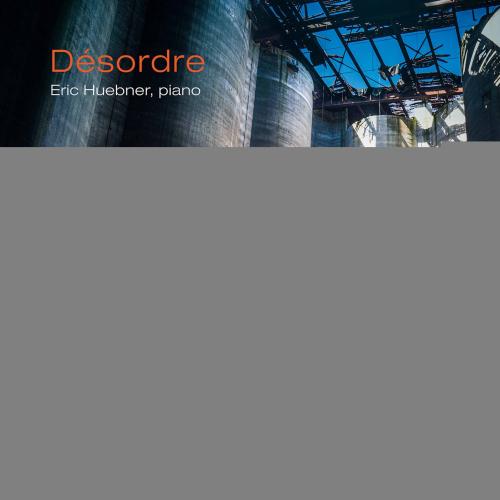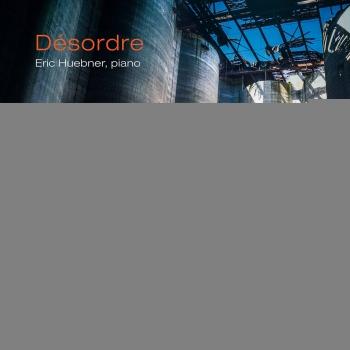
Désordre Eric Huebner
Album info
Album-Release:
2020
HRA-Release:
25.09.2020
Label: New Focus Recordings
Genre: Classical
Subgenre: Instrumental
Artist: Eric Huebner
Composer: György Ligeti (1923–2006)
Album including Album cover Booklet (PDF)
- György Ligeti (1923 - 2006): Études pour piano, Livre I:
- 1 Études pour piano, Livre I: No. 1, Désordre 02:22
- 2 Études pour piano, Livre I: No. 2, Cordes à vide 03:18
- 3 Études pour piano, Livre I: No. 3, Touches bloquées 02:00
- 4 Études pour piano, Livre I: No. 4, Fanfares 03:31
- 5 Études pour piano, Livre I: No. 5, Arc-en-ciel 03:25
- 6 Études pour piano, Livre I: No. 6, Automne à varsovie 04:28
- Études pour piano, Livre II:
- 7 Études pour piano, Livre II: No. 1, Galamb borong 02:31
- 8 Études pour piano, Livre II: No. 2, Fém 02:46
- 9 Études pour piano, Livre II: No. 3, Vertige 03:06
- 10 Études pour piano, Livre II: No. 4, Der Zauberlehrling 02:15
- 11 Études pour piano, Livre II: No. 5, En suspens 02:31
- 12 Études pour piano, Livre II: No. 6, Entrelacs 02:51
- 13 Études pour piano, Livre II: No. 7, L'escalier du diable 05:19
- 14 Études pour piano, Livre II: No. 8, Columna infinită 01:59
- Trio for Violin, Horn & Piano:
- 15 Trio for Violin, Horn & Piano: I. Andante con tenerezza 06:20
- 16 Trio for Violin, Horn & Piano: II. Vivacissimo molto ritmico 05:03
- 17 Trio for Violin, Horn & Piano: III. Alla marcia 03:16
- 18 Trio for Violin, Horn & Piano: IV. Lamento. Adagio 07:00
Info for Désordre
Pianist Eric Huebner’s virtuosic release of Ligeti’s iconic etudes alongside his Trio for Violin, Horn, and Piano underscores the composer’s restless nature and attraction to various sources of aesthetic inspiration. Throughout the 1970s—after fourteen years in exile—György Ligeti made a number of return trips to his native Hungary. He had hoped to rekindle a relationship with the musical community of his homeland and reestablish himself as a ‘Hungarian’ composer. By the end of the decade, though, these efforts fizzled out, coinciding with a prolonged bout of illness and a fallow creative period. The works on this disc—the Études pour Piano (Livres I-II) and the Trio for Violin, Horn, and Piano (Hommage à Brahms)— followed this period of crisis in Ligeti’s life and marked a decisive stylistic shift in his output. This new style drew on, among other things, elements of neo-romanticism, alternate tunings and microtonality, curious flirtations with tonal harmony, Central European folk idioms, and a stunning diversity of non-Western traditions. The point was not his virtuosic ability to inhabit an array of contemporary and historical styles, but rather his inability to settle wholly in any one.
It could be said that Ligeti’s Horn Trio (1982) inaugurated this new trajectory both in its style and in its thematic inspirations. When the pianist, Eckart Besch, first approached Ligeti about composing a companion piece to the Brahms trio for violin, piano, and natural horn, the suggestion evidently sparked powerful associations. There are, for instance, well-documented personal associations for Ligeti between the sound of the natural horn and the alpenhorns he heard in the Carpathian Mountains as a child. In his Romanian Concerto of 1951, the natural horn solo of the third movement explicitly recalled these childhood memories. In the opening measures of Ligeti’s trio, the horn part bears an immediate resemblance to that earlier work. Furthermore, this horn melody unfolds over a skewed quotation, by the violin, of the ‘Lebewohl’ (“farewell”) horn call that opens Beethoven’s Piano Sonata, Op. 81a.
Ligeti named Chopin, Schumann, Scarlatti, and Debussy as primary influences in composing his first two books of piano etudes (1985-1994). Ligeti was by no means a virtuoso pianist, but he wrote his piano etudes at the keyboard and aimed to preserve that traditional sense of the genre as virtuosic technical study. In a playful subversion of the romantic pianist channeling musical ideas with sublime facility through a machine, Ligeti inserts his body as a faulty mechanical intermediary. Two machines—body and piano—engage in dialogue, producing unpredictable effects on the passage from thought to expression.
Beyond obvious predecessors like Chopin and Debussy, the influences suffusing Ligeti’s piano etudes hail from innumerable disparate places. He explores interests in fractal geometry, chaos theory, and the machine-like cacophony of Conlon Nancarrow’s player piano works (especially evident in Désordre, Cordes à vide, and L’escalier du diable, for example). Moments of jazz harmony, à la Thelonious Monk and Bill Evans, percolate throughout the etudes and positively define the sound-worlds of Arc-en-ciel and En Suspens. Elements of Central European folk music surface frequently, too, as in the descending lamento motif that pervades Automne à Varsovie and the Bulgarian dance rhythms (aksak) of Fanfares.
Non-Western elements also abound. As Ligeti writes,“[t]he polyphonic ensemble playing of several musicians on the xylophone—in Uganda, the Central African Republic, Malawi and other places—as well as the playing of a single performer on a lamellophone (mbira, likembe, or sanza) in Zimbabwe, the Cameroon, and many other regions, led me to search for similar technical possibilities on the piano keys”. Galamb Borong, by contrast, evokes the sound of a gamelan orchestra. Its Hungarian title, which translates rather absurdly as “ Melancholic Pigeon,” was likewise chosen for its supposedly Javanese sound.
The existential plight of being stuck between states with no place to call home is an apt organizing metaphor for these works. Looking past the dominance of machines, patterns, and inhuman systems, though, the piano etudes do make a certain kind of space for human presence. For instance, Ligeti paid much attention to the physical experience of playing these works, claiming that the “well-formed piano work produces physical pleasure” in the way that it choreographs the body. Indeed, for all their pyrotechnic glitz, Ligeti’s etudes lie remarkably well in the hands, allowing for a surprising degree of expressive freedom. If a recurring theme here has been the cataclysm between imagined ideals and the failure of their realization, it nevertheless seems that something unforeseen is able to glow into life above the wreckage. We might say that this is music about finding moments of comfort for oneself in an inhospitable world: an increasingly virtuosic feat. These studies, in other words, think pianistically about displacement and refuge. For this reason, they remain not only contemporary, but also utterly timely.
Eric Huebner, piano
Yuki Numata Resnick, violin
Adam Unsworth, horn
Eric Huebner
has drawn worldwide acclaim for his performances of new and traditional music since making his debut with the Los Angeles Philharmonic at age 17. In January 2012, he was appointed pianist of the New York Philharmonic and made his solo debut with the orchestra in June 2012 with the New York Premiere of Elliott Carter’s Two Controversies and a Conversation for piano, percussion and chamber orchestra with Musicians of the New York Philharmonic, Colin Currie, percussion and David Robertson conducting as part of the CONTACT! series. He has previously collaborated with Mr. Robertson in performances of György Ligeti’s Piano Concerto and Olivier Messiaen’s Oiseaux Exotiques. From 2001 through 2012, Huebner was a member of Antares, a quartet comprised of clarinet, violin, cello and piano. First-prize winners of the 2002 Concert Artists Guild International Competition, Antares appeared regularly in major chamber music venues throughout the country.
A frequent visitor to the west coast, Mr. Huebner has twice been a featured recitalist at the Ojai Festival in California and given solo performances on the Monday Evening Concerts and Piano Spheres series in Los Angeles as well as at the Carlsbad New Music Festival. He appears regularly with the New York Philharmonic in performances at Avery Fisher Hall and on tour throughout the world as well as in chamber music venues with musicians from the orchestra. He’s been a frequent guest at conservatories and universities throughout the United States, performing solo recitals and giving master classes.
Mr. Huebner is currently Assistant Professor of Music at the University at Buffalo where he maintains an active piano studio, serves as pianist for the Slee Sinfonietta and directs the June in Buffalo Performance Institute. He was also recently appointed adjunct faculty member at The Juilliard School where he teaches a class in orchestral piano performance. His performances have been broadcast on PBS and NPR, and on radio stations KMOZ (Los Angeles), WNYC (New York), Radio Bremen (Germany), ORF (Austria) and the BBC. He has recorded for Col Legno, Centaur, Bridge, Albany, Tzadik, Innova, New Focus Recordings and Mode Records. Mr. Huebner holds a B.M. and M.M. from The Juilliard School where he studied with Jerome Lowenthal.
Booklet for Désordre












